Adsorption of Ag⁺ ions using hydroxyapatite powder and recovery silver by electrodepositio
Nowadays, waste of electrical and electronic apparatuses generated in huge amount surround the earth and has
become a global environmental issue. Electronic waste contains large amounts of metal ions, such as Au, Ag, Cu, Pd,
Pb and Cd etc., resulting in a threat to the environment, ecosystems and human health. Therefore, removal of metal ions
and recovery of precious metals are extremely necessary. Hydroxyapatite material was reported that they can remove
heavy metal ions in water with high efficiency. In this work, Ag+ ions in water were adsorbed using hydroxyapatite
(HAp) powder and recovery silver by electrodeposition. The adsorption efficiency of silver was about 61 % at 50 oC
after 60 minutes of contact time. The Ag+ adsorption process using HAp powder followed Langmuir adsorption
isotherms with the maximum monolayer adsorption capacity of 18.7 mg/g. 60 % of silver can recovery by
electrodeposition after 4 hours at the apply current of 10 mA at 50 °C
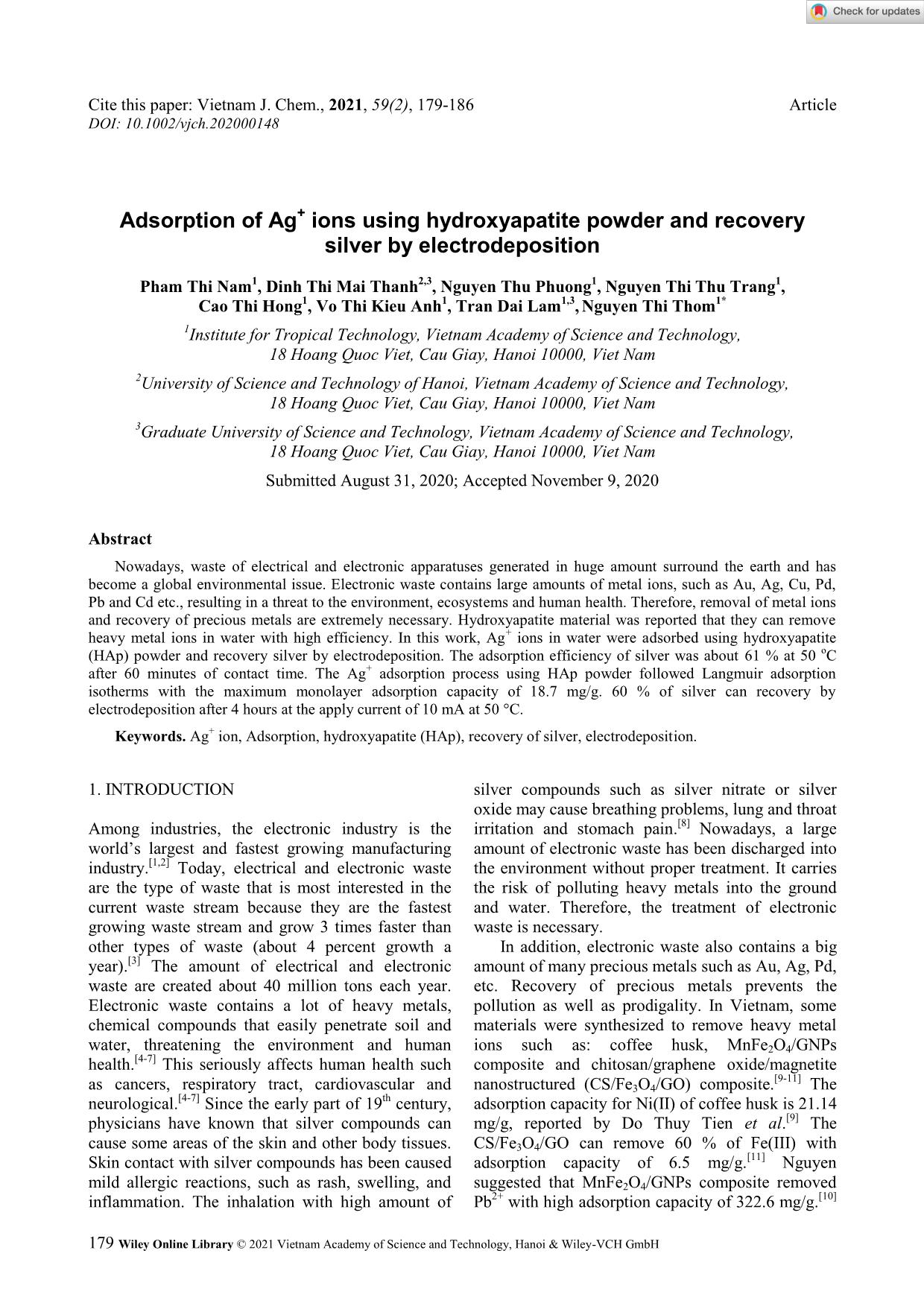
Trang 1
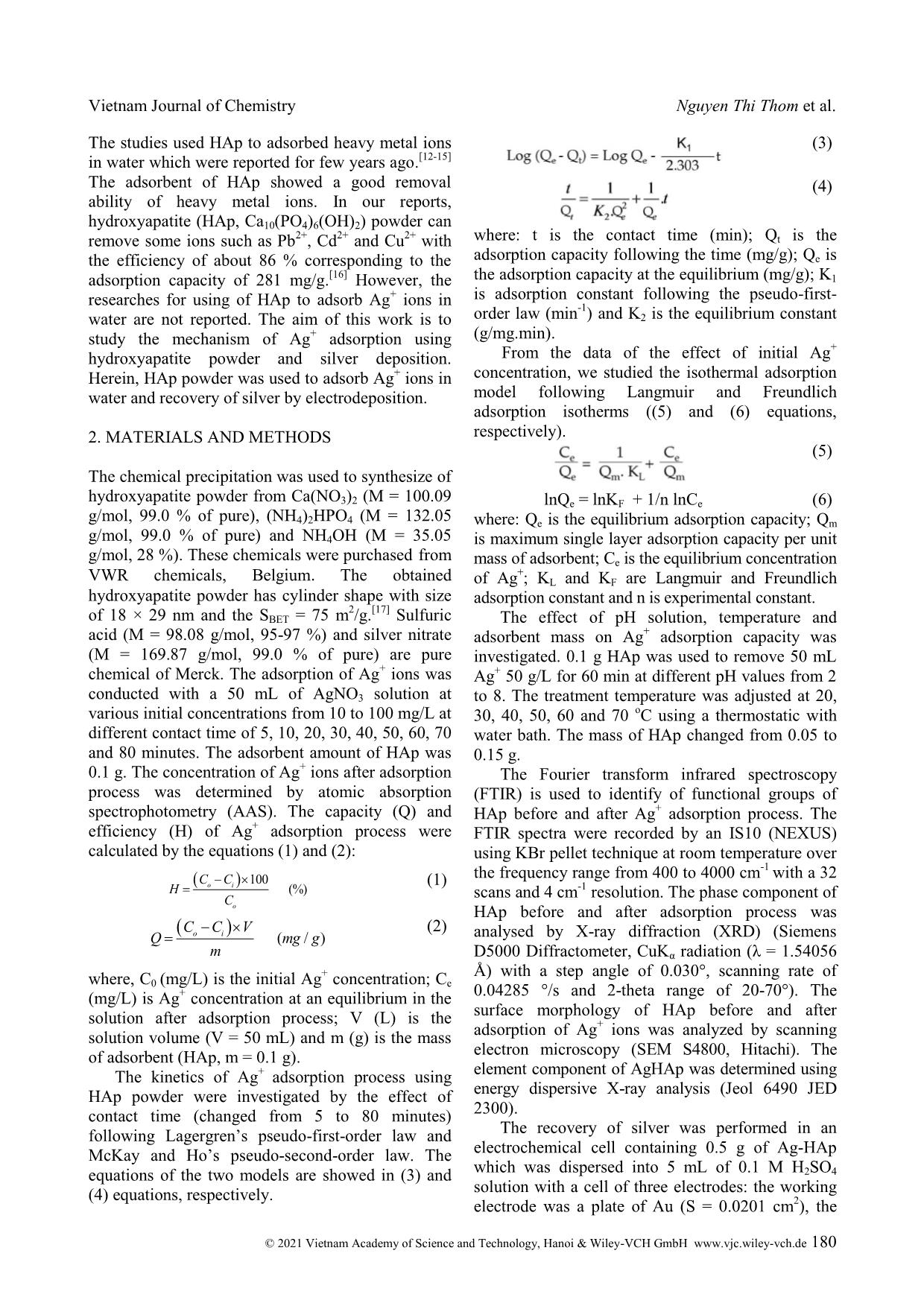
Trang 2
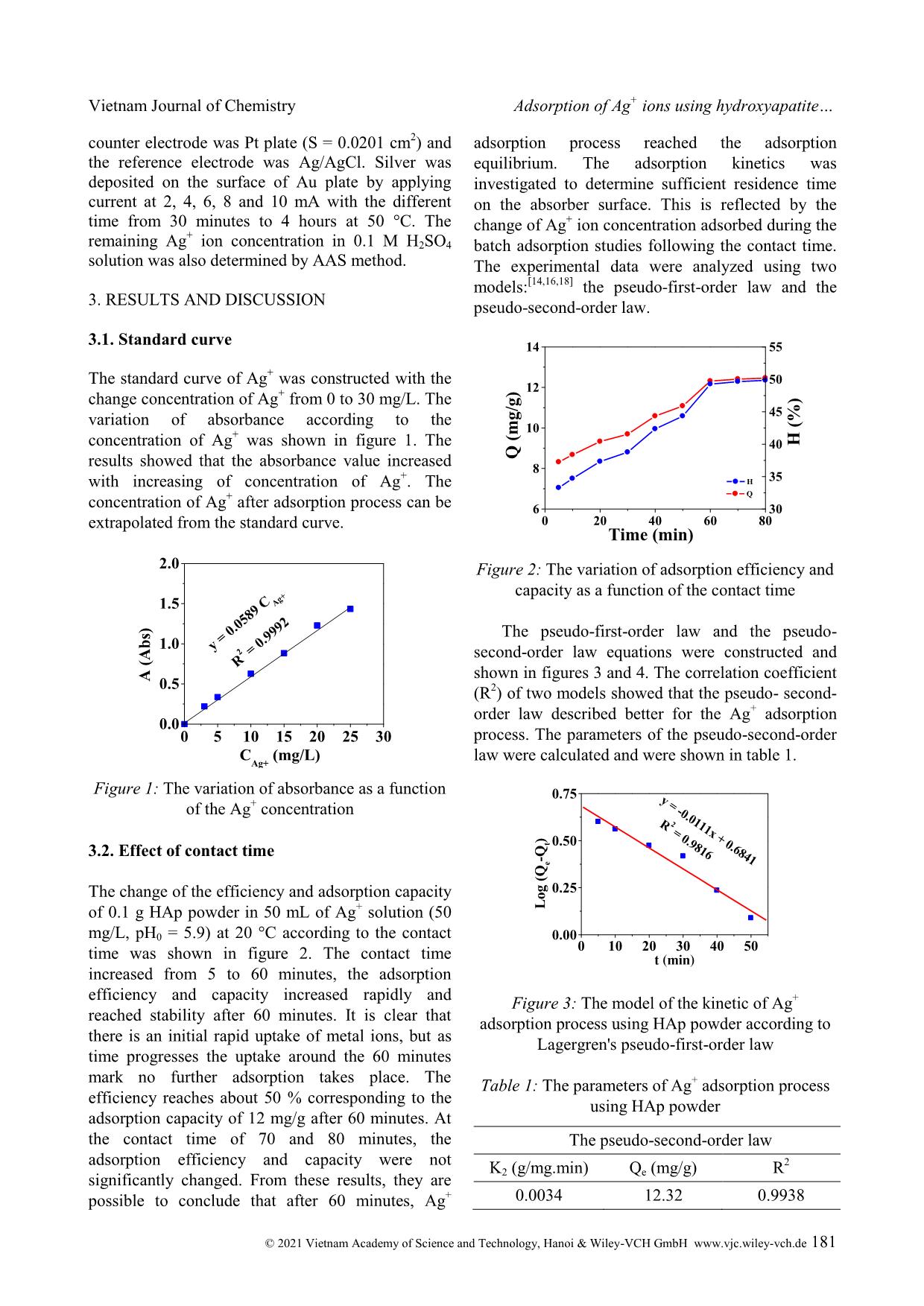
Trang 3
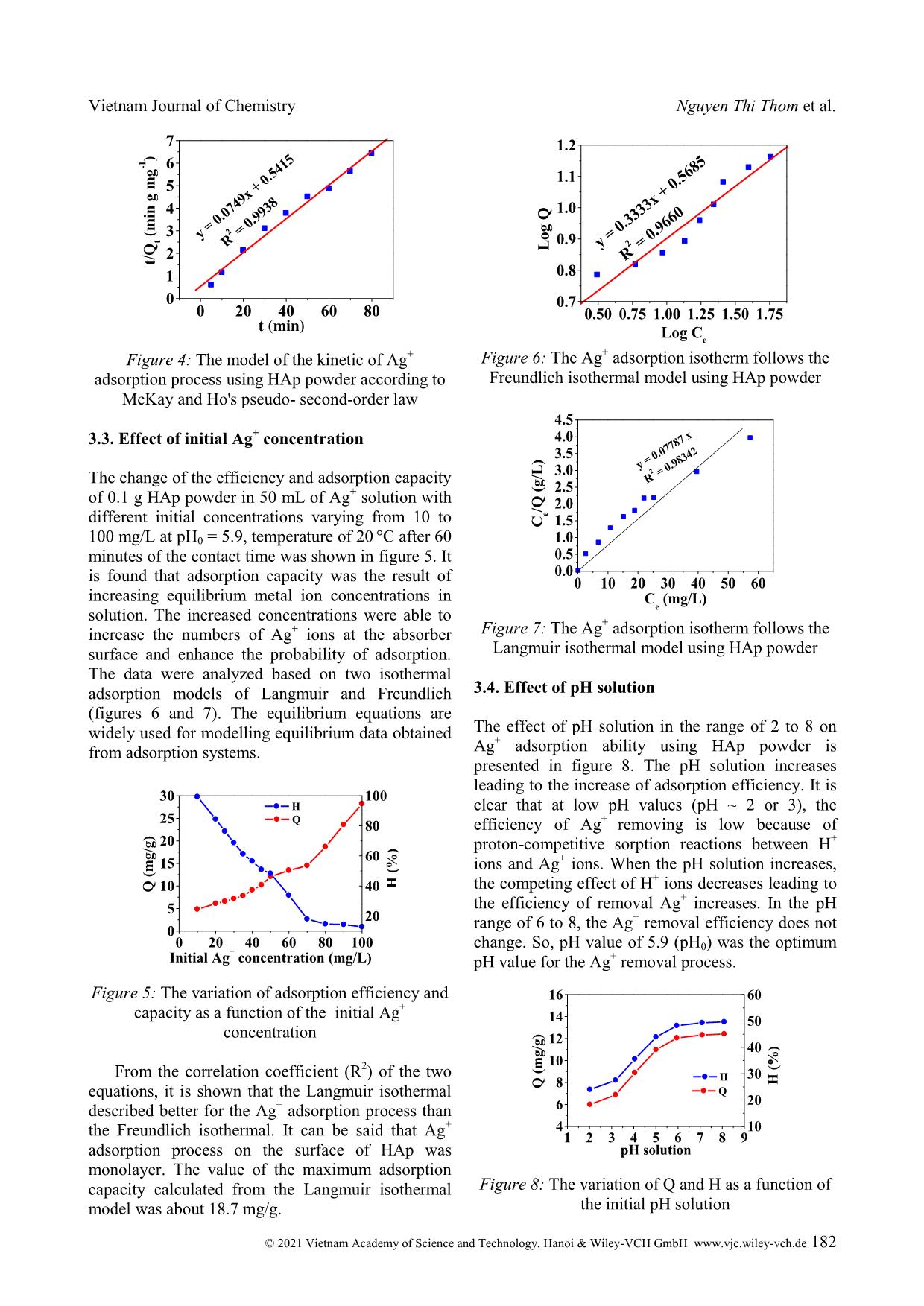
Trang 4
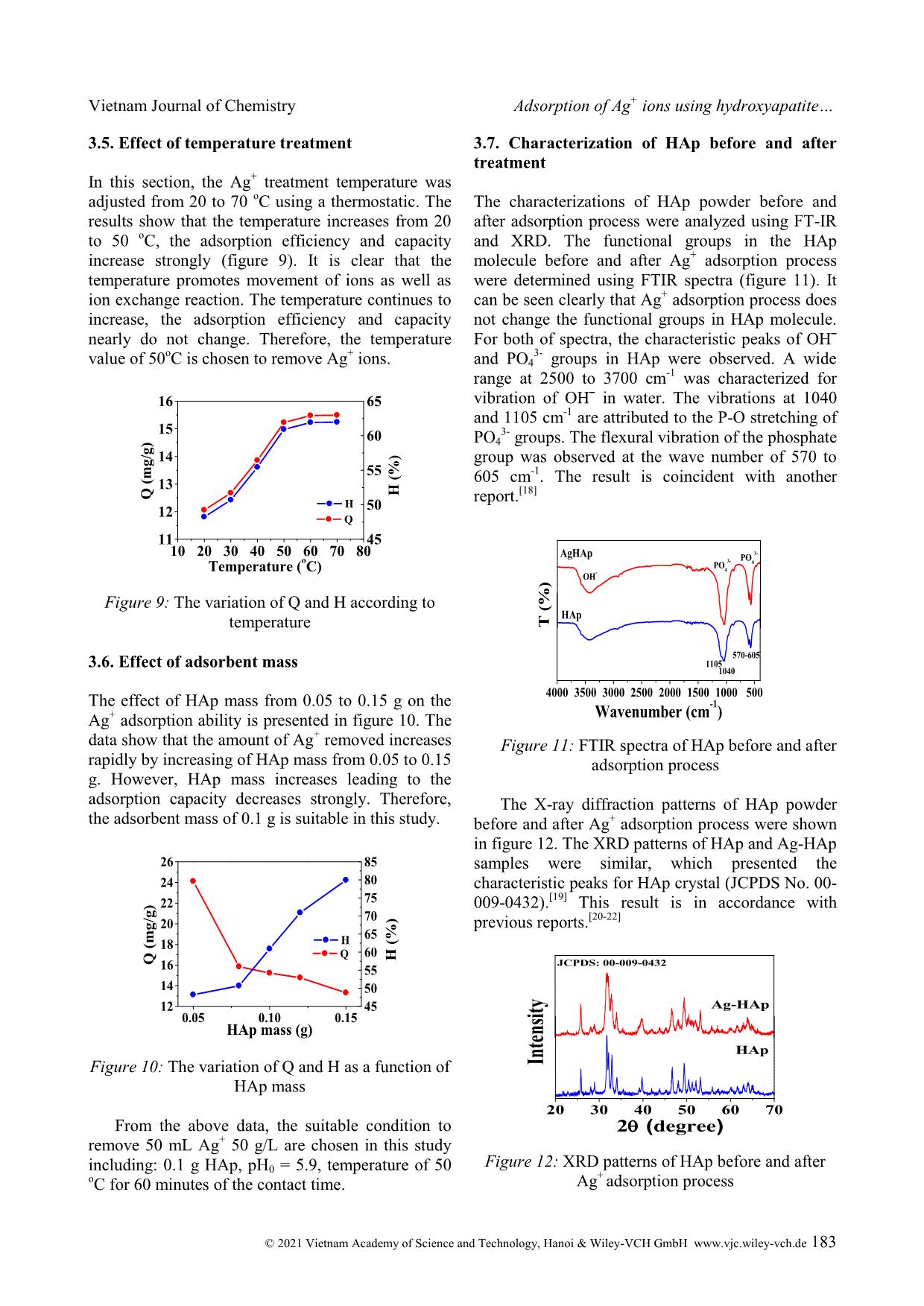
Trang 5
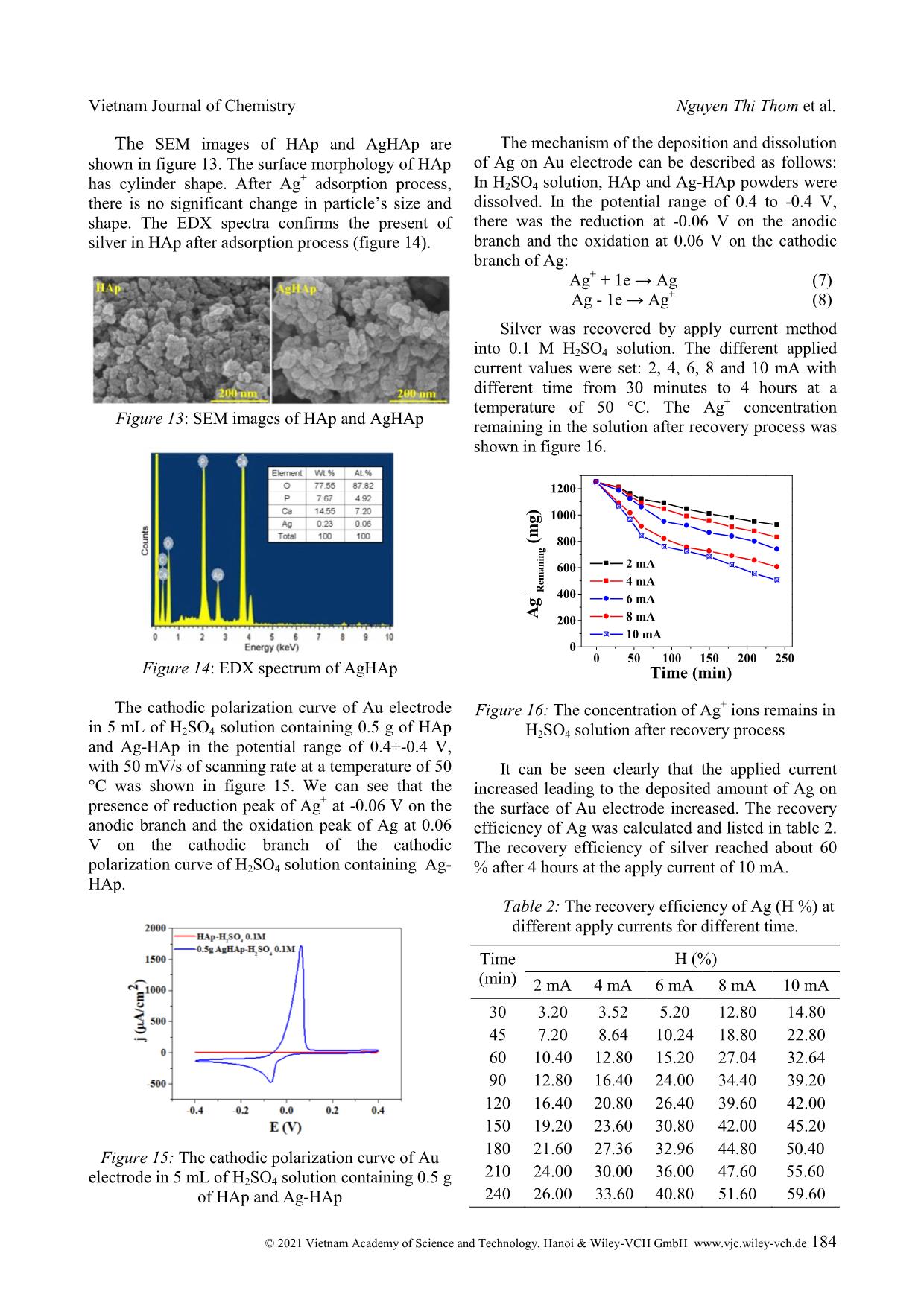
Trang 6
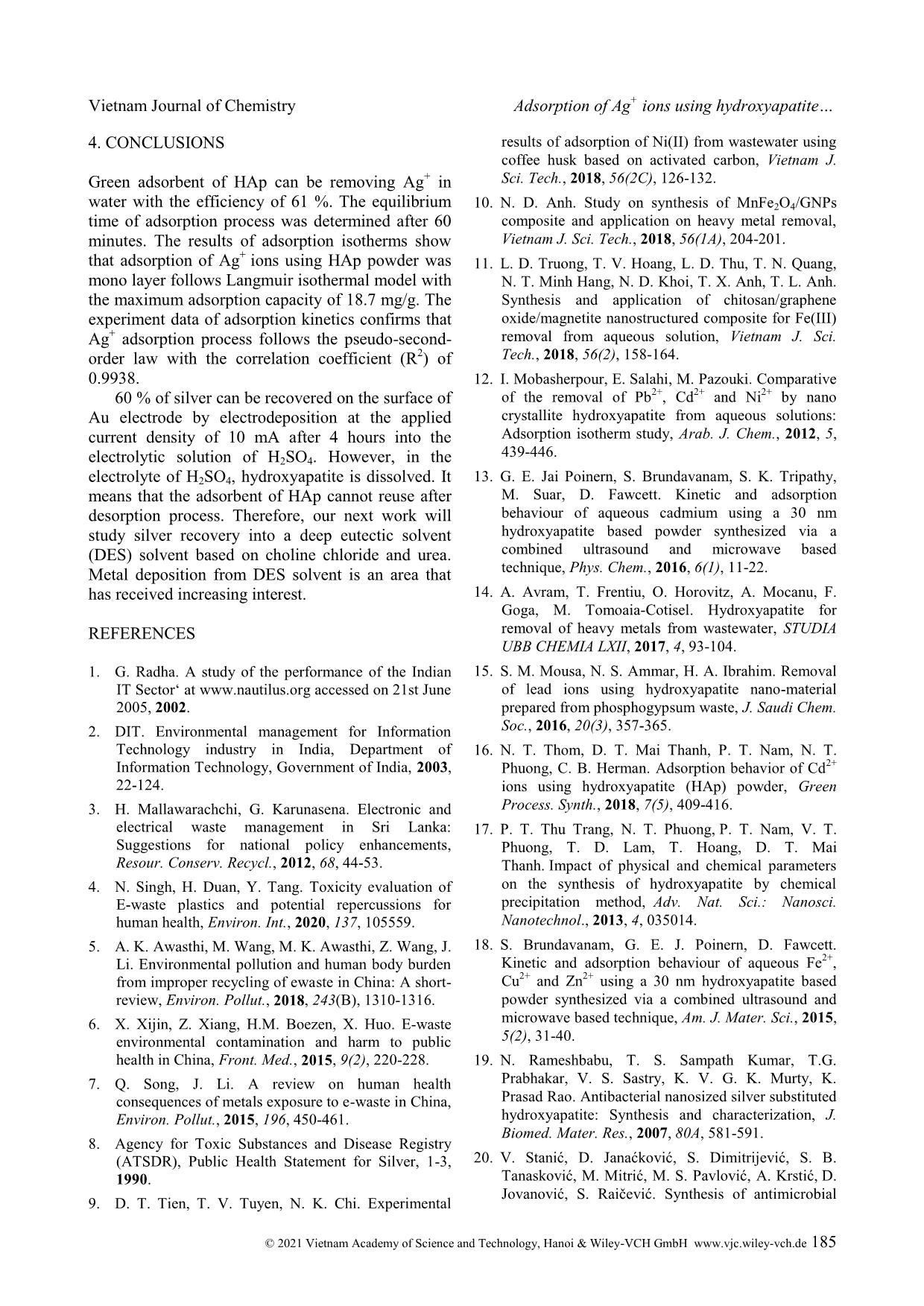
Trang 7
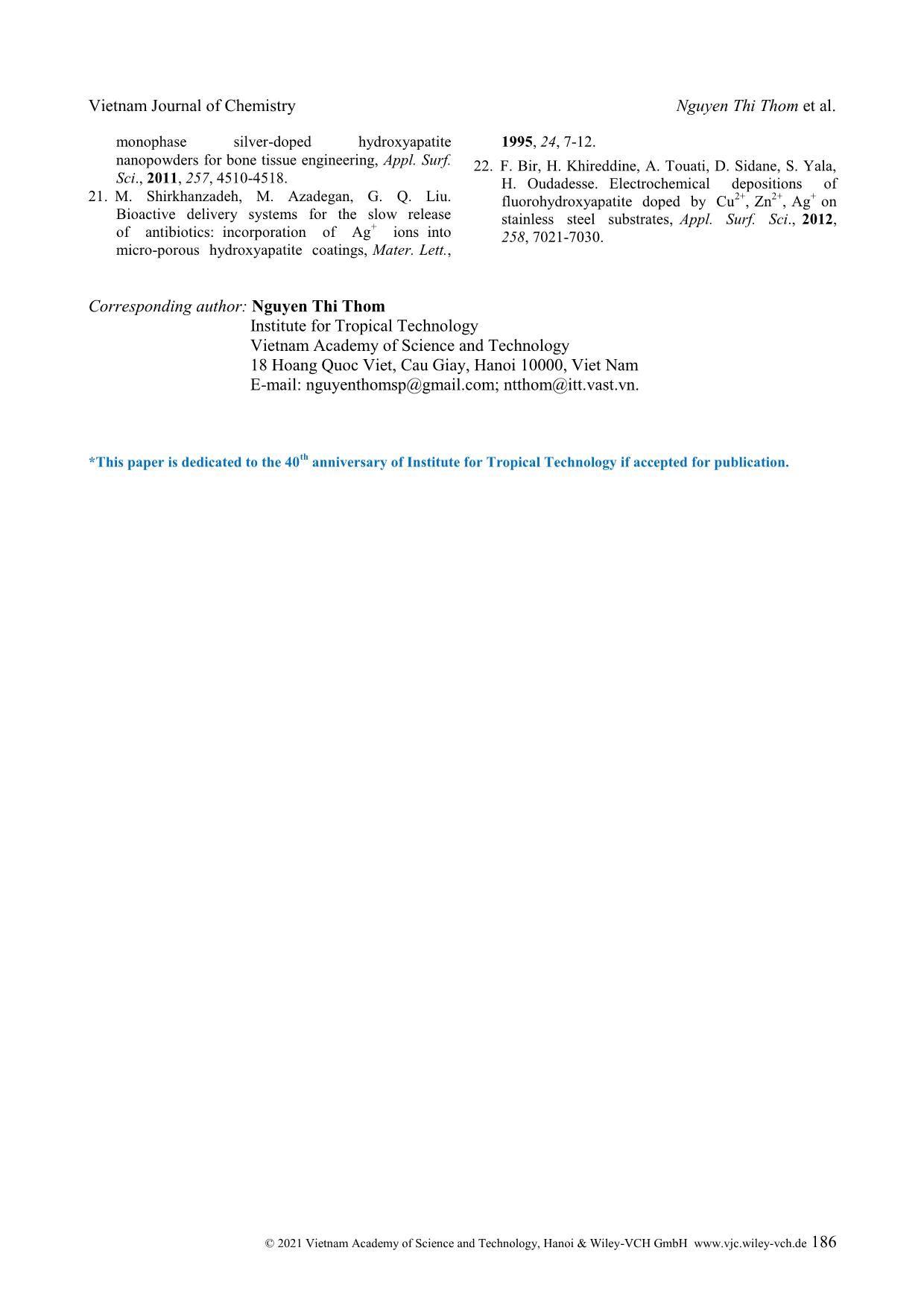
Trang 8
Tóm tắt nội dung tài liệu: Adsorption of Ag⁺ ions using hydroxyapatite powder and recovery silver by electrodepositio
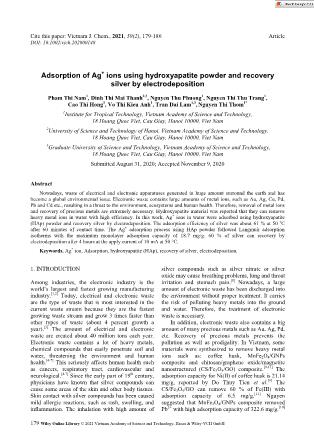
Cite this paper: Vietnam J. Chem., 2021, 59(2), 179-186 Article DOI: 10.1002/vjch.202000148 179 Wiley Online Library © 2021 Vietnam Academy of Science and Technology, Hanoi & Wiley-VCH GmbH Adsorption of Ag+ ions using hydroxyapatite powder and recovery silver by electrodeposition Pham Thi Nam 1 , Dinh Thi Mai Thanh 2,3 , Nguyen Thu Phuong 1 , Nguyen Thi Thu Trang 1 , Cao Thi Hong 1 , Vo Thi Kieu Anh 1 , Tran Dai Lam 1,3 , Nguyen Thi Thom 1* 1 Institute for Tropical Technology, Vietnam Academy of Science and Technology, 18 Hoang Quoc Viet, Cau Giay, Hanoi 10000, Viet Nam 2 University of Science and Technology of Hanoi, Vietnam Academy of Science and Technology, 18 Hoang Quoc Viet, Cau Giay, Hanoi 10000, Viet Nam 3 Graduate University of Science and Technology, Vietnam Academy of Science and Technology, 18 Hoang Quoc Viet, Cau Giay, Hanoi 10000, Viet Nam Submitted August 31, 2020; Accepted November 9, 2020 Abstract Nowadays, waste of electrical and electronic apparatuses generated in huge amount surround the earth and has become a global environmental issue. Electronic waste contains large amounts of metal ions, such as Au, Ag, Cu, Pd, Pb and Cd etc., resulting in a threat to the environment, ecosystems and human health. Therefore, removal of metal ions and recovery of precious metals are extremely necessary. Hydroxyapatite material was reported that they can remove heavy metal ions in water with high efficiency. In this work, Ag + ions in water were adsorbed using hydroxyapatite (HAp) powder and recovery silver by electrodeposition. The adsorption efficiency of silver was about 61 % at 50 o C after 60 minutes of contact time. The Ag + adsorption process using HAp powder followed Langmuir adsorption isotherms with the maximum monolayer adsorption capacity of 18.7 mg/g. 60 % of silver can recovery by electrodeposition after 4 hours at the apply current of 10 mA at 50 °C. Keywords. Ag + ion, Adsorption, hydroxyapatite (HAp), recovery of silver, electrodeposition. 1. INTRODUCTION Among industries, the electronic industry is the world’s largest and fastest growing manufacturing industry. [1,2] Today, electrical and electronic waste are the type of waste that is most interested in the current waste stream because they are the fastest growing waste stream and grow 3 times faster than other types of waste (about 4 percent growth a year). [3] The amount of electrical and electronic waste are created about 40 million tons each year. Electronic waste contains a lot of heavy metals, chemical compounds that easily penetrate soil and water, threatening the environment and human health. [4-7] This seriously affects human health such as cancers, respiratory tract, cardiovascular and neurological. [4-7] Since the early part of 19 th century, physicians have known that silver compounds can cause some areas of the skin and other body tissues. Skin contact with silver compounds has been caused mild allergic reactions, such as rash, swelling, and inflammation. The inhalation with high amount of silver compounds such as silver nitrate or silver oxide may cause breathing problems, lung and throat irritation and stomach pain. [8] Nowadays, a large amount of electronic waste has been discharged into the environment without proper treatment. It carries the risk of polluting heavy metals into the ground and water. Therefore, the treatment of electronic waste is necessary. In addition, electronic waste also contains a big amount of many precious metals such as Au, Ag, Pd, etc. Recovery of precious metals prevents the pollution as well as prodigality. In Vietnam, some materials were synthesized to remove heavy metal ions such as: coffee husk, MnFe2O4/GNPs composite and chitosan/graphene oxide/magnetite nanostructured (CS/Fe3O4/GO) composite. [9-11] The adsorption capacity for Ni(II) of coffee husk is 21.14 mg/g, reported by Do Thuy Tien et al. [9] The CS/Fe3O4/GO can remove 60 % of Fe(III) with adsorption capacity of 6.5 mg/g. [11] Nguyen suggested that MnFe2O4/GNPs composite removed Pb 2+ with high adsorption capacity of 322.6 mg/g. [10] Vietnam Journal of Chemistry Nguyen Thi Thom et al. © 2021 Vietnam Academy of Science and Technology, Hanoi & Wiley-VCH GmbH www.vjc.wiley-vch.de 180 The studies used HAp to adsorbed heavy metal ions in water which were reported for few years ago. [12-15] The adsorbent of HAp showed a good removal ability of heavy metal ions. In our reports, hydroxyapatite (HAp, Ca10(PO4)6(OH)2) powder can remove some ions such as Pb 2+ , Cd 2+ and Cu 2+ with the efficiency of about 86 % corresponding to the adsorption capacity of 281 mg/g. [16] However, the researches for using of HAp to adsorb Ag + ions in water are not reported. The aim of this work is to study the mechanism of Ag + adsorption using hydroxyapatite powder and silver deposition. Herein, HAp powder was used to adsorb Ag + ions in water and recovery of silver by electrodeposition. 2. MATERIALS AND METHODS The chemical precipitation was used to synthesize of hydroxyapatite powder from Ca(NO3)2 (M = 100.09 g/mol, 99.0 % of pure), (NH4)2HPO4 (M = 132.05 g/mol, 99.0 % of pure) and NH4OH (M = 35.05 g/mol, 28 %). These chemicals were purchased from VWR chemicals, Belgium. The obtained hydroxyapatite powder has cylinder shape with size of 18 × 29 nm and the SBET = 75 m 2 /g. [17] Sulfuric acid (M = 98.08 g/mol, 95-97 %) and silver nitrate (M = 169.87 g/mol, 99.0 % of pure) are pure chemical of Merck. The adsorption of Ag + ions was conducted with a 50 mL of AgNO3 solution at various initial concentrations from 10 to 100 mg/L at different contact time of 5, 10, 20, 30, 40, 50, 60, 70 and 80 minutes. The adsorbent amount of HAp was 0.1 g. The concentration of ... 1.00 1.25 1.50 1.75 0.7 0.8 0.9 1.0 1.1 1.2 L o g Q Log C e y = 0. 33 33 x + 0. 56 85 R 2 = 0 .9 66 0 Figure 6: The Ag + adsorption isotherm follows the Freundlich isothermal model using HAp powder 0 10 20 30 40 50 60 0.0 0.5 1.0 1.5 2.0 2.5 3.0 3.5 4.0 4.5 C e/ Q ( g /L ) C e (mg/L) y = 0. 07 78 7 x R 2 = 0.9 83 42 Figure 7: The Ag + adsorption isotherm follows the Langmuir isothermal model using HAp powder 3.4. Effect of pH solution The effect of pH solution in the range of 2 to 8 on Ag + adsorption ability using HAp powder is presented in figure 8. The pH solution increases leading to the increase of adsorption efficiency. It is clear that at low pH values (pH ~ 2 or 3), the efficiency of Ag + removing is low because of proton-competitive sorption reactions between H + ions and Ag + ions. When the pH solution increases, the competing effect of H + ions decreases leading to the efficiency of removal Ag + increases. In the pH range of 6 to 8, the Ag + removal efficiency does not change. So, pH value of 5.9 (pH0) was the optimum pH value for the Ag + removal process. 1 2 3 4 5 6 7 8 9 4 6 8 10 12 14 16 Q pH solution Q ( m g /g ) 10 20 30 40 50 60 H H ( % ) Figure 8: The variation of Q and H as a function of the initial pH solution Vietnam Journal of Chemistry Adsorption of Ag + ions using hydroxyapatite © 2021 Vietnam Academy of Science and Technology, Hanoi & Wiley-VCH GmbH www.vjc.wiley-vch.de 183 3.5. Effect of temperature treatment In this section, the Ag + treatment temperature was adjusted from 20 to 70 o C using a thermostatic. The results show that the temperature increases from 20 to 50 o C, the adsorption efficiency and capacity increase strongly (figure 9). It is clear that the temperature promotes movement of ions as well as ion exchange reaction. The temperature continues to increase, the adsorption efficiency and capacity nearly do not change. Therefore, the temperature value of 50 o C is chosen to remove Ag + ions. 10 20 30 40 50 60 70 80 11 12 13 14 15 16 Q Temperature ( o C) Q ( m g /g ) 45 50 55 60 65 H H ( % ) Figure 9: The variation of Q and H according to temperature 3.6. Effect of adsorbent mass The effect of HAp mass from 0.05 to 0.15 g on the Ag + adsorption ability is presented in figure 10. The data show that the amount of Ag + removed increases rapidly by increasing of HAp mass from 0.05 to 0.15 g. However, HAp mass increases leading to the adsorption capacity decreases strongly. Therefore, the adsorbent mass of 0.1 g is suitable in this study. 0.05 0.10 0.15 12 14 16 18 20 22 24 26 Q HAp mass (g) Q ( m g /g ) 45 50 55 60 65 70 75 80 85 H H ( % ) Figure 10: The variation of Q and H as a function of HAp mass From the above data, the suitable condition to remove 50 mL Ag + 50 g/L are chosen in this study including: 0.1 g HAp, pH0 = 5.9, temperature of 50 o C for 60 minutes of the contact time. 3.7. Characterization of HAp before and after treatment The characterizations of HAp powder before and after adsorption process were analyzed using FT-IR and XRD. The functional groups in the HAp molecule before and after Ag + adsorption process were determined using FTIR spectra (figure 11). It can be seen clearly that Ag + adsorption process does not change the functional groups in HAp molecule. For both of spectra, the characteristic peaks of OHˉ and PO4 3- groups in HAp were observed. A wide range at 2500 to 3700 cm -1 was characterized for vibration of OHˉ in water. The vibrations at 1040 and 1105 cm -1 are attributed to the P-O stretching of PO4 3- groups. The flexural vibration of the phosphate group was observed at the wave number of 570 to 605 cm -1 . The result is coincident with another report. [18] 4000 3500 3000 2500 2000 1500 1000 500 570-605 1040 1105 AgHAp HAp Wavenumber (cm -1 ) T ( % ) PO 4 3- PO 4 3- OH - Figure 11: FTIR spectra of HAp before and after adsorption process The X-ray diffraction patterns of HAp powder before and after Ag + adsorption process were shown in figure 12. The XRD patterns of HAp and Ag-HAp samples were similar, which presented the characteristic peaks for HAp crystal (JCPDS No. 00- 009-0432). [19] This result is in accordance with previous reports. [20-22] 20 30 40 50 60 70 JCPDS: 00-009-0432 HAp 2 (degree) In te ns it y Ag-HAp Figure 12: XRD patterns of HAp before and after Ag + adsorption process Vietnam Journal of Chemistry Nguyen Thi Thom et al. © 2021 Vietnam Academy of Science and Technology, Hanoi & Wiley-VCH GmbH www.vjc.wiley-vch.de 184 The SEM images of HAp and AgHAp are shown in figure 13. The surface morphology of HAp has cylinder shape. After Ag + adsorption process, there is no significant change in particle’s size and shape. The EDX spectra confirms the present of silver in HAp after adsorption process (figure 14). Figure 13: SEM images of HAp and AgHAp Figure 14: EDX spectrum of AgHAp The cathodic polarization curve of Au electrode in 5 mL of H2SO4 solution containing 0.5 g of HAp and Ag-HAp in the potential range of 0.4÷-0.4 V, with 50 mV/s of scanning rate at a temperature of 50 °C was shown in figure 15. We can see that the presence of reduction peak of Ag + at -0.06 V on the anodic branch and the oxidation peak of Ag at 0.06 V on the cathodic branch of the cathodic polarization curve of H2SO4 solution containing Ag- HAp. Figure 15: The cathodic polarization curve of Au electrode in 5 mL of H2SO4 solution containing 0.5 g of HAp and Ag-HAp The mechanism of the deposition and dissolution of Ag on Au electrode can be described as follows: In H2SO4 solution, HAp and Ag-HAp powders were dissolved. In the potential range of 0.4 to -0.4 V, there was the reduction at -0.06 V on the anodic branch and the oxidation at 0.06 V on the cathodic branch of Ag: Ag + + 1e → Ag (7) Ag - 1e → Ag+ (8) Silver was recovered by apply current method into 0.1 M H2SO4 solution. The different applied current values were set: 2, 4, 6, 8 and 10 mA with different time from 30 minutes to 4 hours at a temperature of 50 °C. The Ag + concentration remaining in the solution after recovery process was shown in figure 16. 0 50 100 150 200 250 0 200 400 600 800 1000 1200 Time (min) A g + R em a n in g ( m g ) 2 mA 4 mA 6 mA 8 mA 10 mA Figure 16: The concentration of Ag + ions remains in H2SO4 solution after recovery process It can be seen clearly that the applied current increased leading to the deposited amount of Ag on the surface of Au electrode increased. The recovery efficiency of Ag was calculated and listed in table 2. The recovery efficiency of silver reached about 60 % after 4 hours at the apply current of 10 mA. Table 2: The recovery efficiency of Ag (H %) at different apply currents for different time. Time (min) H (%) 2 mA 4 mA 6 mA 8 mA 10 mA 30 3.20 3.52 5.20 12.80 14.80 45 7.20 8.64 10.24 18.80 22.80 60 10.40 12.80 15.20 27.04 32.64 90 12.80 16.40 24.00 34.40 39.20 120 16.40 20.80 26.40 39.60 42.00 150 19.20 23.60 30.80 42.00 45.20 180 21.60 27.36 32.96 44.80 50.40 210 24.00 30.00 36.00 47.60 55.60 240 26.00 33.60 40.80 51.60 59.60 Vietnam Journal of Chemistry Adsorption of Ag + ions using hydroxyapatite © 2021 Vietnam Academy of Science and Technology, Hanoi & Wiley-VCH GmbH www.vjc.wiley-vch.de 185 4. CONCLUSIONS Green adsorbent of HAp can be removing Ag + in water with the efficiency of 61 %. The equilibrium time of adsorption process was determined after 60 minutes. The results of adsorption isotherms show that adsorption of Ag + ions using HAp powder was mono layer follows Langmuir isothermal model with the maximum adsorption capacity of 18.7 mg/g. The experiment data of adsorption kinetics confirms that Ag + adsorption process follows the pseudo-second- order law with the correlation coefficient (R 2 ) of 0.9938. 60 % of silver can be recovered on the surface of Au electrode by electrodeposition at the applied current density of 10 mA after 4 hours into the electrolytic solution of H2SO4. However, in the electrolyte of H2SO4, hydroxyapatite is dissolved. It means that the adsorbent of HAp cannot reuse after desorption process. Therefore, our next work will study silver recovery into a deep eutectic solvent (DES) solvent based on choline chloride and urea. Metal deposition from DES solvent is an area that has received increasing interest. REFERENCES 1. G. Radha. A study of the performance of the Indian IT Sector‘ at www.nautilus.org accessed on 21st June 2005, 2002. 2. DIT. Environmental management for Information Technology industry in India, Department of Information Technology, Government of India, 2003, 22-124. 3. H. Mallawarachchi, G. Karunasena. Electronic and electrical waste management in Sri Lanka: Suggestions for national policy enhancements, Resour. Conserv. Recycl., 2012, 68, 44-53. 4. N. Singh, H. Duan, Y. Tang. Toxicity evaluation of E-waste plastics and potential repercussions for human health, Environ. Int., 2020, 137, 105559. 5. A. K. Awasthi, M. Wang, M. K. Awasthi, Z. Wang, J. Li. Environmental pollution and human body burden from improper recycling of ewaste in China: A short- review, Environ. Pollut., 2018, 243(B), 1310-1316. 6. X. Xijin, Z. Xiang, H.M. Boezen, X. Huo. E-waste environmental contamination and harm to public health in China, Front. Med., 2015, 9(2), 220-228. 7. Q. Song, J. Li. A review on human health consequences of metals exposure to e-waste in China, Environ. Pollut., 2015, 196, 450-461. 8. Agency for Toxic Substances and Disease Registry (ATSDR), Public Health Statement for Silver, 1-3, 1990. 9. D. T. Tien, T. V. Tuyen, N. K. Chi. Experimental results of adsorption of Ni(II) from wastewater using coffee husk based on activated carbon, Vietnam J. Sci. Tech., 2018, 56(2C), 126-132. 10. N. D. Anh. Study on synthesis of MnFe2O4/GNPs composite and application on heavy metal removal, Vietnam J. Sci. Tech., 2018, 56(1A), 204-201. 11. L. D. Truong, T. V. Hoang, L. D. Thu, T. N. Quang, N. T. Minh Hang, N. D. Khoi, T. X. Anh, T. L. Anh. Synthesis and application of chitosan/graphene oxide/magnetite nanostructured composite for Fe(III) removal from aqueous solution, Vietnam J. Sci. Tech., 2018, 56(2), 158-164. 12. I. Mobasherpour, E. Salahi, M. Pazouki. Comparative of the removal of Pb 2+ , Cd 2+ and Ni 2+ by nano crystallite hydroxyapatite from aqueous solutions: Adsorption isotherm study, Arab. J. Chem., 2012, 5, 439-446. 13. G. E. Jai Poinern, S. Brundavanam, S. K. Tripathy, M. Suar, D. Fawcett. Kinetic and adsorption behaviour of aqueous cadmium using a 30 nm hydroxyapatite based powder synthesized via a combined ultrasound and microwave based technique, Phys. Chem., 2016, 6(1), 11-22. 14. A. Avram, T. Frentiu, O. Horovitz, A. Mocanu, F. Goga, M. Tomoaia-Cotisel. Hydroxyapatite for removal of heavy metals from wastewater, STUDIA UBB CHEMIA LXII, 2017, 4, 93-104. 15. S. M. Mousa, N. S. Ammar, H. A. Ibrahim. Removal of lead ions using hydroxyapatite nano-material prepared from phosphogypsum waste, J. Saudi Chem. Soc., 2016, 20(3), 357-365. 16. N. T. Thom, D. T. Mai Thanh, P. T. Nam, N. T. Phuong, C. B. Herman. Adsorption behavior of Cd 2+ ions using hydroxyapatite (HAp) powder, Green Process. Synth., 2018, 7(5), 409-416. 17. P. T. Thu Trang, N. T. Phuong, P. T. Nam, V. T. Phuong, T. D. Lam, T. Hoang, D. T. Mai Thanh. Impact of physical and chemical parameters on the synthesis of hydroxyapatite by chemical precipitation method, Adv. Nat. Sci.: Nanosci. Nanotechnol., 2013, 4, 035014. 18. S. Brundavanam, G. E. J. Poinern, D. Fawcett. Kinetic and adsorption behaviour of aqueous Fe 2+ , Cu 2+ and Zn 2+ using a 30 nm hydroxyapatite based powder synthesized via a combined ultrasound and microwave based technique, Am. J. Mater. Sci., 2015, 5(2), 31-40. 19. N. Rameshbabu, T. S. Sampath Kumar, T.G. Prabhakar, V. S. Sastry, K. V. G. K. Murty, K. Prasad Rao. Antibacterial nanosized silver substituted hydroxyapatite: Synthesis and characterization, J. Biomed. Mater. Res., 2007, 80A, 581-591. 20. V. Stanić, D. Janaćković, S. Dimitrijević, S. B. Tanasković, M. Mitrić, M. S. Pavlović, A. Krstić, D. Jovanović, S. Raičević. Synthesis of antimicrobial Vietnam Journal of Chemistry Nguyen Thi Thom et al. © 2021 Vietnam Academy of Science and Technology, Hanoi & Wiley-VCH GmbH www.vjc.wiley-vch.de 186 monophase silver-doped hydroxyapatite nanopowders for bone tissue engineering, Appl. Surf. Sci., 2011, 257, 4510-4518. 21. M. Shirkhanzadeh, M. Azadegan, G. Q. Liu. Bioactive delivery systems for the slow release of antibiotics: incorporation of Ag + ions into micro-porous hydroxyapatite coatings, Mater. Lett., 1995, 24, 7-12. 22. F. Bir, H. Khireddine, A. Touati, D. Sidane, S. Yala, H. Oudadesse. Electrochemical depositions of fluorohydroxyapatite doped by Cu 2+ , Zn 2+ , Ag + on stainless steel substrates, Appl. Surf. Sci., 2012, 258, 7021-7030. Corresponding author: Nguyen Thi Thom Institute for Tropical Technology Vietnam Academy of Science and Technology 18 Hoang Quoc Viet, Cau Giay, Hanoi 10000, Viet Nam E-mail: nguyenthomsp@gmail.com; ntthom@itt.vast.vn. *This paper is dedicated to the 40 th anniversary of Institute for Tropical Technology if accepted for publication.
File đính kèm:
 adsorption_of_ag_ions_using_hydroxyapatite_powder_and_recove.pdf
adsorption_of_ag_ions_using_hydroxyapatite_powder_and_recove.pdf

